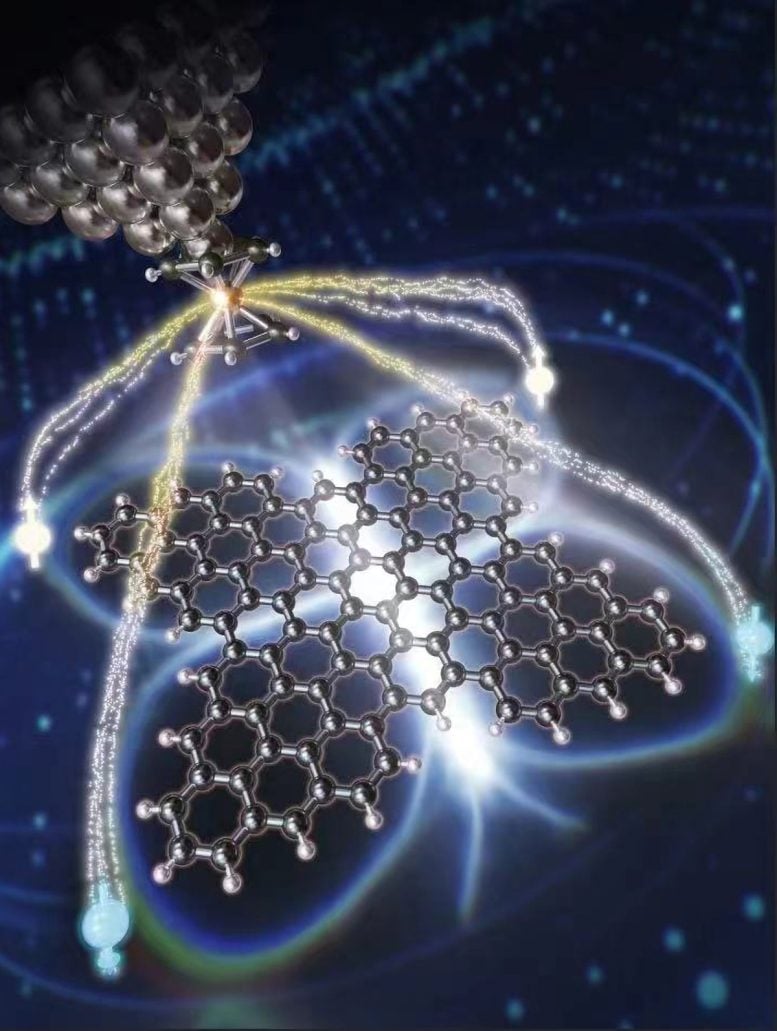"Revolutionary Design Unveiled: Magnetic Butterfly Paves the Way for Next-Gen Quantum Materials"

NUS researchers created a butterfly-shaped magnetic nanographene, advancing quantum information technologies with its unique correlated spins. This discovery offers potential for next-gen qubits with improved coherence times. Credit: National University of Singapore
NUS researchers have created a new butterfly-shaped magnetic nanographene that could improve quantum computing by enabling better control of electron spins and extending the coherence times of quantum bits.
Researchers from the National University of Singapore (NUS) have unveiled a groundbreaking design concept for next-generation carbon-based quantum materials. They created a tiny, butterfly-shaped magnetic nanographene that hosts highly correlated spins, showcasing significant potential for advancements in quantum information technologies.
Magnetic nanographene, a tiny structure made of graphene molecules, exhibits remarkable magnetic properties due to the behavior of specific electrons in the carbon atoms’ π-orbitals. Unlike conventional magnetic materials produced using heavy metals, where the different types of electrons from d- or f-orbitals are involved, carbon’s π-electrons play a unique role. By precisely designing the arrangement of these carbon atoms at the nanoscale, control over the behavior of these unique electrons can be achieved.
This renders nanographene highly promising for creating extremely small magnets and for fabricating the basic components, known as quantum bits or qubits, essential for the development of quantum computers. High-quality qubits need to maintain their quantum state for an extended duration known as coherence time while operating quickly. Carbon-based materials are known to extend the coherence times of spin qubits, due to their two unique properties: weak spin-orbit and hyperfine couplings that effectively prevent decoherence of electron spins.
Figure illustrating a visual impression of the magnetic “butterfly” hosting four entangled spins on “wings” (left) and its corresponding atomic-scale image obtained using scanning probe microscopy (right). Credit: National University of Singapore
The team of researchers led by Associate Professor LU Jiong from the NUS Department of Chemistry and Institute for Functional Intelligent Materials, together with Professor Jishan WU also from the NUS Department of Chemistry, and international collaborators, have developed a method for designing and creating a large fully-fused butterfly-shaped magnetic nanographene. This unique structure has four rounded triangles resembling butterfly wings, with each of these wings holding an unpaired π-electron responsible for the observed magnetic properties. This accomplishment is attributed to the atomic-precise design of the π-electron network in the nanostructured graphene.
Assoc Prof Lu said, “Magnetic nanographene, a tiny molecule composed of fused benzene rings, holds significant promise as a next-generation quantum material for hosting fascinating quantum spins due to its chemical versatility and long spin coherence time. However, creating multiple highly entangled spins in such systems is a daunting yet essential task for building scalable and complex quantum networks.”
This significant achievement stems from a close collaboration among synthetic chemists, materials scientists, and physicists, including key contributors Professor Pavel Jelinek and Dr Libor Vei, both from the Czech Academy of Sciences in Prague.
The research breakthrough was recently published in the scientific journal Nature Chemistry.
The magnetic properties of nanographene are usually derived from the arrangement of its special electrons, known as π-electrons, or the strength of their interactions. However, it is difficult to make these properties work together to create multiple correlated spins. Also, nanographene predominately exhibits a singular magnetic order, where spins align either in the same direction (ferromagnetic) or in opposite directions (antiferromagnetic).
NUS researchers Assoc Prof Lu Jiong (left), Prof Wu Jishan (right) and Dr Song Shaotang (middle) were part of the multidisciplinary research team which developed the butterfly-shaped magnetic nanographene which could be used for quantum technologies. Credit: National University of Singapore
The researchers developed a new kind of magnetic nanographene to overcome these challenges. They created a nanographene, with both ferromagnetic and antiferromagnetic properties, that has a butterfly shape, made by combining four smaller triangles into a rhombus at the center, measuring approximately 3 nanometres in size.




